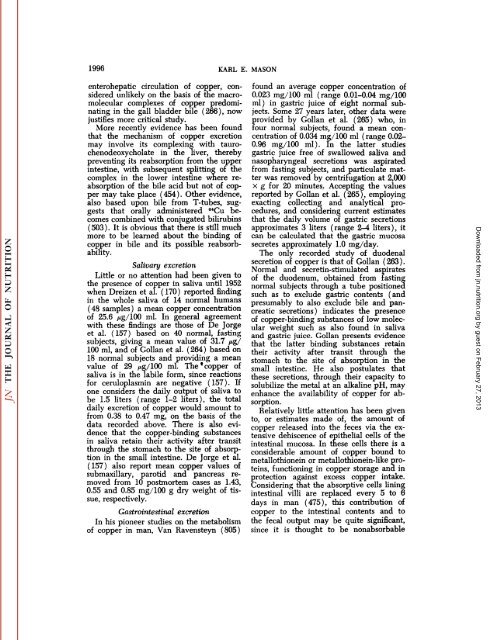conspectus of researchon copper metabolism and requirements
conspectus of researchon copper metabolism and requirements
conspectus of researchon copper metabolism and requirements
You also want an ePaper? Increase the reach of your titles
YUMPU automatically turns print PDFs into web optimized ePapers that Google loves.
1996 KARL E. MASON<br />
enterohepatic circulation <strong>of</strong> <strong>copper</strong>, con<br />
sidered unlikely on the basis <strong>of</strong> the macromolecular<br />
complexes <strong>of</strong> <strong>copper</strong> predomi<br />
nating in the gall bladder bile (266), now<br />
justifies more critical study.<br />
More recently evidence has been found<br />
that the mechanism <strong>of</strong> <strong>copper</strong> excretion<br />
may involve its complexing with taurochenodeoxycholate<br />
in the liver, thereby<br />
preventing its reabsorption from the upper<br />
intestine, with subsequent splitting <strong>of</strong> the<br />
complex in the lower intestine where reabsorption<br />
<strong>of</strong> the bile acid but not <strong>of</strong> cop<br />
per may take place (454). Other evidence,<br />
also based upon bile from T-tubes, sug<br />
gests that orally administered 04Cu be<br />
comes combined with conjugated bilirubins<br />
(503 ). It is obvious that there is still much<br />
more to be learned about the binding <strong>of</strong><br />
<strong>copper</strong> in bile <strong>and</strong> its possible reabsorbability.<br />
Salivary excretion<br />
Little or no attention had been given to<br />
the presence <strong>of</strong> <strong>copper</strong> in saliva until 1952<br />
when Dreizen et al. ( 170) reported finding<br />
in the whole saliva <strong>of</strong> 14 normal humans<br />
(48 samples) a mean <strong>copper</strong> concentration<br />
<strong>of</strong> 25.6 /Ag/100 ml. In general agreement<br />
with these findings are those <strong>of</strong> De Jorge<br />
et al. (157) based on 40 normal, fasting<br />
subjects, giving a mean value <strong>of</strong> 31.7 /¿g/<br />
100 ml, <strong>and</strong> <strong>of</strong> Gollan et al. (264) based on<br />
18 normal subjects <strong>and</strong> providing a mean<br />
value <strong>of</strong> 29 /¿g/100ml. The ' <strong>copper</strong> <strong>of</strong><br />
saliva is in the labile form, since reactions<br />
for ceruloplasmin are negative (157). If<br />
one considers the daily output <strong>of</strong> saliva to<br />
be 1.5 liters (range 1-2 liters), the total<br />
daily excretion <strong>of</strong> <strong>copper</strong> would amount to<br />
from 0.38 to 0.47 mg, on the basis <strong>of</strong> the<br />
data recorded above. There is also evi<br />
dence that the <strong>copper</strong>-binding substances<br />
in saliva retain their activity after transit<br />
through the stomach to the site <strong>of</strong> absorp<br />
tion in the small intestine. De Jorge et al.<br />
(157) also report mean <strong>copper</strong> values <strong>of</strong><br />
submaxillary, parotid <strong>and</strong> pancreas re<br />
moved from 10 postmortem cases as 1.43,<br />
0.55 <strong>and</strong> 0.85 mg/100 g dry weight <strong>of</strong> tis<br />
sue, respectively.<br />
Gastrointestinal excretion<br />
In his pioneer studies on the <strong>metabolism</strong><br />
<strong>of</strong> <strong>copper</strong> in man, Van Ravensteyn (805)<br />
found an average <strong>copper</strong> concentration <strong>of</strong><br />
0.023 mg/100 ml (range 0.01-0.04 mg/100<br />
ml) in gastric juice <strong>of</strong> eight normal sub<br />
jects. Some 27 years later, other data were<br />
provided by Gollan et al. (265) who, in<br />
four normal subjects, found a mean con<br />
centration <strong>of</strong> 0.034 mg/100 ml (range 0.02-<br />
0.96 mg/100 ml). In the latter studies<br />
gastric juice free <strong>of</strong> swallowed saliva <strong>and</strong><br />
nasopharyngeal secretions was aspirated<br />
from fasting subjects, <strong>and</strong> particulate mat<br />
ter was removed by centrifugation at 2,000<br />
X g for 20 minutes. Accepting the values<br />
reported by Gollan et al. (265), employing<br />
exacting collecting <strong>and</strong> analytical pro<br />
cedures, <strong>and</strong> considering current estimates<br />
that the daily volume <strong>of</strong> gastric secretions<br />
approximates 3 liters (range 2-4 liters), it<br />
can be calculated that the gastric mucosa<br />
secretes approximately 1.0 mg/day.<br />
The only recorded study <strong>of</strong> duodenal<br />
secretion <strong>of</strong> <strong>copper</strong> is that <strong>of</strong> Gollan (263 ).<br />
Normal <strong>and</strong> secretin-stimulated aspirates<br />
<strong>of</strong> the duodenum, obtained from fasting<br />
normal subjects through a tube positioned<br />
such as to exclude gastric contents (<strong>and</strong><br />
presumably to also exclude bile <strong>and</strong> pan<br />
creatic secretions) indicates the presence<br />
<strong>of</strong> <strong>copper</strong>-binding substances <strong>of</strong> low molec<br />
ular weight such as also found in saliva<br />
<strong>and</strong> gastric juice. Gollan presents evidence<br />
that the latter binding substances retain<br />
their activity after transit through the<br />
stomach to the site <strong>of</strong> absorption in the<br />
small intestine. He also postulates that<br />
these secretions, through their capacity to<br />
solubilize the metal at an alkaline pH, may<br />
enhance the availability <strong>of</strong> <strong>copper</strong> for ab<br />
sorption.<br />
Relatively little attention has been given<br />
to, or estimates made <strong>of</strong>, the amount <strong>of</strong><br />
<strong>copper</strong> released into the feces via the ex<br />
tensive dehiscence <strong>of</strong> epithelial cells <strong>of</strong> the<br />
intestinal mucosa. In these cells there is a<br />
considerable amount <strong>of</strong> <strong>copper</strong> bound to<br />
metallothionein or metallothionein-like pro<br />
teins, functioning in <strong>copper</strong> storage <strong>and</strong> in<br />
protection against excess <strong>copper</strong> intake.<br />
Considering that the absorptive cells lining<br />
intestinal villi are replaced every 5 to 6<br />
days in man (475), this contribution <strong>of</strong><br />
<strong>copper</strong> to the intestinal contents <strong>and</strong> to<br />
the fecal output may be quite significant,<br />
since it is thought to be nonabsorbable<br />
Downloaded from<br />
jn.nutrition.org<br />
by guest on February 27, 2013
















